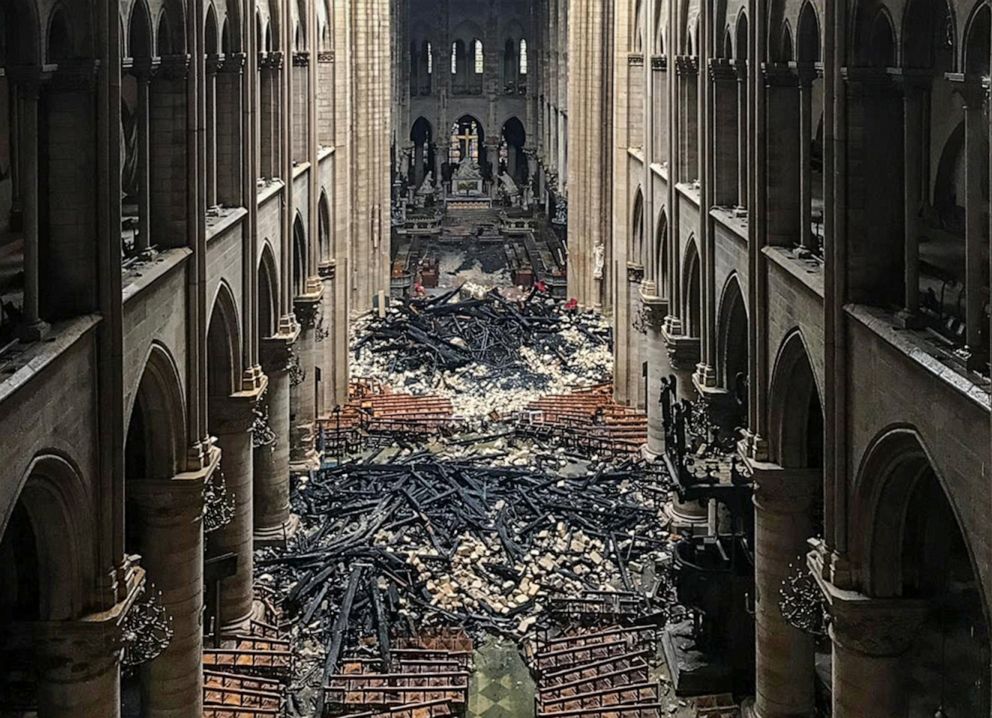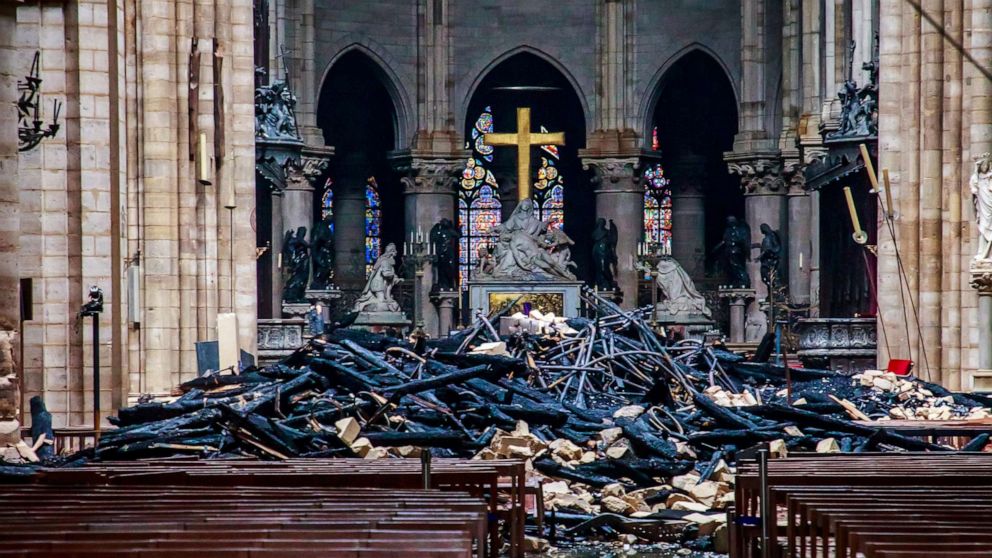I'm not sure which is more remarkable. The cathedral's ability to survive fires, or this thread to survive attempted flounders. ![]()
I'm not sure which is more remarkable. The cathedral's ability to survive fires, or this thread to survive attempted flounders. ![]()
Fire in old buildings seem to spread very rapidly. We lost a very nice old glove factory that was being converted to apartments.
Construction work started the fire. Our excellent fire department couldn't put the fire out in time to save the building , total loss.
The Paris fire department did a good job saving what they did.
Flying low over a blazing building can be tricky.
A lot has been said on this post by people who were not in Paris.
Grizz said:My only thought about it is that if the plans for "fixing" the cathedral involve some tumor of glass and steel it might be time to dust off the guillotine again.
Which is usually what happens when people start throwing around the term modern like I've been seeing.
The Europeans actually have a much better attitude towards this than we in the States do.
They tend to make modern additions to old buildings because the change in aesthetic makes it crystal clear where the original ends and the addition / modification / reconstruction begins. Counterintuitively, having the new work look contemporary strengthens the architectural presence of the original part rather than weakening it through imitation.
Americans, on the other hand, want everything to "fit in" so badly that a large quantity of poorly designed, badly scaled, fake copies of older styles are built with only a very superficial understanding of actual historical design. Counterintuitively, this cheapens and dilutes the power of the originals.
I assume having so much less history than Europe does makes America desperate to generate the appearance of it.
I absolutely love the idea that they planted trees a hundred years ago just in case. Bravo.
I'm a bit confused as to what got Gary so worked up, but I'd like to think he is just passionate about that building and is upset that it burned and feels the need to blame someone or something. That sort of passion just goes to show you how awe inspiring the building is.
Duke said:Grizz said:My only thought about it is that if the plans for "fixing" the cathedral involve some tumor of glass and steel it might be time to dust off the guillotine again.
Which is usually what happens when people start throwing around the term modern like I've been seeing.The Europeans actually have a much better attitude towards this than we in the States do.
They tend to make modern additions to old buildings because the change in aesthetic makes it crystal clear where the original ends and the addition / modification / reconstruction begins. Counterintuitively, having the new work look contemporary strengthens the architectural presence of the original part rather than weakening it through imitation.
Americans, on the other hand, want everything to "fit in" so badly that a large quantity of poorly designed, badly scaled, fake copies of older styles are built with only a very superficial understanding of actual historical design. Counterintuitively, this cheapens and dilutes the power of the originals.
I assume having so much less history than Europe does makes America desperate to generate the appearance of it.
It may also have to do with the relative value of "old". Notre Dame was not a one-and-done building. It's been modified and burned and neglected and fixed and modified over 800 years. It's a living structure. In the US, stuff tends to get preserved because "old" means 200 years at most and it's still pretty much the way it was when it was built.
Recreating the original roof with a steel and glass structure would be interesting to see, especially if the broken vaulted ceiling over the altar is given a skylight. That could have quite an effect on the space and it could be absolutely gorgeous. Stone cathedral design was always a race to get the biggest possible windows into the building, see St. Chapelle in Paris.
All that being said, bad architecture is bad architecture. It exists in all eras and styles. But just being different or modern is not inherently bad.
My town is living proof of that. In the last 25 years we have grown from a mid-size town to a small city, but the general populace still wants to pretend it's the same small town from the '50s and '60s.
So rather than coming to grips with the increasing density and change from rural to urban fabric, what we wound up with is a lot of apartment-building-sized McMansions on stilts, poorly plastered over with a putrid blend of fauxstorical styles that were never really associated with this region anyway.
If they do a modern addition / reconstruction, they still have to do it well. But that doesn't come from the choice of style; that comes from the quality of the design.
Some recent inside pictures-


Looks like most of the damage was from the falling rock arches vs. fire- the timbers I see are part of the roof structure. More indications that the PFD did a great job. Actually, they are called the BSPP- Brigade des sapeurs-pompiers de Paris.
Glad to see so much stained glass still intact. From the inferno pictures, I assumed most of that would be destroyed.
Duke said:Glad to see so much stained glass still intact. From the inferno pictures, I assumed most of that would be destroyed.
Those where my exact thoughts when I saw those pics.
Not sure if this style of construction can hold the weight of much more than wood for a roof, it's Called a Buttruss wall and gets it's ability to stay erect by the structures around the base that start as a footing and become a room but they keep the structure from Kicking out at the Bottom , I wouldn't call what they could build 900 years ago A Poor Design, Fact Is More information has been LOST about Construction or hiddin by the free Masons in the last 1000 years than we know now
Grizz said:My only thought about it is that if the plans for "fixing" the cathedral involve some tumor of glass and steel it might be time to dust off the guillotine again.
Which is usually what happens when people start throwing around the term modern like I've been seeing.
Think of it as kintsugi:

Stefan said:So apparently there's a bunch of old oak trees at Versailles that are maintained to provide new beams at Notre Dame if the cathedral should catch fire. They were planted after the last time this happened, ca. 1789-1860.
That's some planning right there.
Can you imagine the beauty of that forest that is about to be cut down to build a tourist trap? I gotta love the irony of it.
Disclaimer..."highly spiritual, but not religious person on keyboard".
Have been to Notre Dame twice. As an engineer, I loved the structure and can get lost in thought picturing the original builders going about their work. Lots of unused space though.
Pete
NOHOME said:
As an engineer... Lots of unused space though.
Ha! Now that that is an engineer's view for sure.
Keith Tanner said:It may also have to do with the relative value of "old". Notre Dame was not a one-and-done building. It's been modified and burned and neglected and fixed and modified over 800 years. It's a living structure. In the US, stuff tends to get preserved because "old" means 200 years at most and it's still pretty much the way it was when it was built.
I remember taking a boat tour around the city of Hamburg. I pointed to a church and said, "Wow, I can't imagine how old that building must be!". The girl that I was with, who was from Hamburg said,"No...that church is only 300 years old. That church over there is 500 years old."
My thought at the time was that the only things in America that were 500 years old were rocks and redwoods.
NOHOME said:Can you imagine the beauty of that tree farm that is about to be cut down to build a tourist trap? I gotta love the irony of it.
In reply to Keith Tanner :
Indeed!
"I do not understand these lumps of fat on this human, they seem ungainly and prone to causing back problems!" -engineer, probably
NOHOME said:Have been to Notre Dame twice. As an engineer, I loved the structure and can get lost in thought picturing the original builders going about their work. Lots of unused space though.
Is it really unused, or was it designed like that for acoustics?
In reply to GTXVette :
I believe the roof was actually lead.
Though most of what we see from outside Notre Dame is stone and glass, much of the inside is buttressed by timber. Builders harvested more than 5,000 oak trees across 52 acres to build the beams, trusses, and reinforcements for the stone structure and to hold up the roof’s 200-metric-ton lead cladding.
So....lead fallout downwind of the fire?
In reply to Woody :
My visit to Amsterdam was like that.
The "New Church" was built in the 15th century.
Woody said:Keith Tanner said:It may also have to do with the relative value of "old". Notre Dame was not a one-and-done building. It's been modified and burned and neglected and fixed and modified over 800 years. It's a living structure. In the US, stuff tends to get preserved because "old" means 200 years at most and it's still pretty much the way it was when it was built.
I remember taking a boat tour around the city of Hamburg. I pointed to a church and said, "Wow, I can't imagine how old that building must be!". The girl that I was with, who was from Hamburg said,"No...that church is only 300 years old. That church over there is 500 years old."
My thought at the time was that the only things in America that were 500 years old were rocks and redwoods.
Nah, we have 1000 year old structures--go check out New Mexico and Arizona. Sure, most of them are ruins, but they're 1000 years old.
Woody said:My thought at the time was that the only things in America that were 500 years old were rocks and redwoods.
Of course, other than the millions of people already here, and the impressive structures built in Central and South America. Our history does not start with Columbus.
The only reason big structures are not common in North America is that the people here were largely nomadic, so no real need for permanent structures like churches made of rocks.
edit- aka +1 to MTN
You'll need to log in to post.